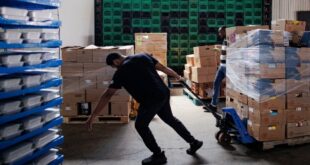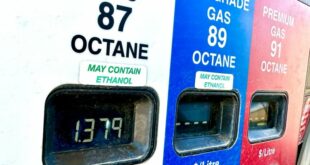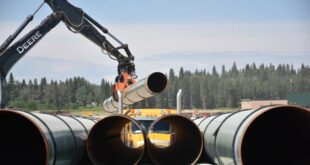Country plans to ramp up ammonia imports to decarbonize coal plants.
Japan plans to import millions of tons of ammonia in the next few years in a push to decarbonize that country’s power generation — an initiative that could present a big opportunity for Alberta’s energy sector.
While Japan was once nearly synonymous with nuclear power, the country’s use of that technology plummeted after the 2011 Fukushima disaster. Today the country has one of the lowest energy self-sufficiency rates of any country in the Organization for Economic Co-operation and Development (OECD) and relies primarily on imports of coal, oil and liquefied natural gas for its energy supply.
It nevertheless has plans to achieve net-zero emissions by 2050 and as part of that plan intends to start co-firing its coal power plants with ammonia, which does not generate carbon dioxide when burned.
The plan is to start with 20 per cent ammonia and increase the percentage over time. Japan also plans to use ammonia as a shipping fuel and to eventually export its fuel ammonia technology to other Asian countries.
‘A great opportunity’
But because the world doesn’t yet produce enough ammonia to support even that 20-per-cent threshold, Japan’s energy needs could present an opening for resource-rich countries like Canada, said Karl Pires, governor of the Canadian Chamber of Commerce in Japan.
“[Japan is] really trying to ramp up in terms of securing the procurement of enough ammonia,” said Pires, who is also a Tokyo-based lawyer specializing in the energy sector.
“It’s a great opportunity.”
Alberta, in particular, is poised to take advantage.
Hydrogen is used to make ammonia, and the province is Canada’s largest hydrogen producer. In the last two years, there have been announcements of low-carbon hydrogen and ammonia partnerships between companies such as Marubeni and Pembina Pipeline; Itochu, Petronas and Inter Pipeline; and Mitsubishi and Shell.
Of course, announcements are not shovels in the ground, and how Japan’s ammonia strategy pans out for both that country — and for Alberta — remains to be seen.
The idea of using ammonia for thermal power generation has faced its share of criticism for being new, expensive and only debatably beneficial to the environment.
Canada’s participation in the industry also depends on getting over supply chain and regulatory hurdles. Pires compared the ammonia opportunity with the hype that surrounded Canada’s plans to export LNG to Japan, which faced various hurdles and were slow to get off the ground.
Still, with the global ammonia market expected to triple by 2050, some say the Japanese bet on low-carbon ammonia is one of many opportunities for Canada in a growing and changing industry.
“The opportunity for Alberta [in low-carbon ammonia] is absolutely huge,” said David Layzell, energy systems architect with the Transition Accelerator, a non-profit organization set up to help Canada reach its climate goals.
Why ammonia?
Made from hydrogen and nitrogen, ammonia is an energy-rich molecule that doesn’t emit carbon dioxide when combusted or converted to energy through a fuel cell, said Layzell.
It can be made from fossil fuels such as natural gas (“grey ammonia”) or from renewable energy (“green ammonia”).
“Blue ammonia” splits the difference: it’s made from natural gas but carbon emissions are captured and stored underground.
Compared to hydrogen, ammonia is more stable and easier to liquify, store and to transport over long distances.
Alberta is well-positioned to make blue ammonia, experts say, because it has abundant natural gas reserves, plus the geology and emerging infrastructure necessary for carbon capture and storage. It’s also on a well-established rail line for transporting goods to the West Coast.

“There’s known and existing routes of getting [ammonia] out of the province that don’t have to be built from scratch,” said Marla Orenstein, director of the natural resources centre at the Canada West Foundation. “We’re ready to go.”
Increasing trade with Alberta is likely also appealing to Japan from an energy security perspective, said Pires, especially given Russia’s role as a major supplier of LNG.
Geoff Bury, CEO of Northern Petrochemical, plans to produce blue ammonia and blue methanol at a proposed plant near Grande Prairie, Alta., a location he believes is “ideally suited” to creating ammonia for export to northeast Asia.
He pointed to Japan’s ammonia strategy, along with a similar policy underway in South Korea, as drivers of demand.
“On the ammonia side, today approximately 80 per cent of ammonia produced worldwide is used in the fertilizer industry,” said Bury. “As time goes on … the real growth is going to be as a hydrogen carrier, and the demand is going to, in our view, skyrocket.”
According to Japan‘s Ministry for Economy, Trade and Industry, the country expects it will need three million tonnes of ammonia per year by 2030 and 30 million tonnes by 2050.
Benefits debated
The ammonia industry also has its critics.
Environmentalists say using it to co-fire coal plants unnecessarily prolongs the use of coal and emits oxides of nitrogen, which can contribute to smog and are yet another type of emission to be dealt with.
It also remains an experimental technology, according to energy finance adviser Grant Hauber, who says even if co-firing works at the scale Japan is targeting, it will continue to emit large amounts of CO2.

There are other challenges, too. Layzell noted that ammonia is a toxic gas and while industry has been successfully transporting it around the world for decades, it hasn’t yet been done at the scale that’s being proposed.
Others have critiqued the cost of the initiative, which BloombergNEF says would be far higher than simply investing in renewables.
“I know countries like Japan and Europe have big goals in terms of how much they want to import in the future, but it is very expensive energy, and so I wonder over time if other alternatives that are cheaper are going to emerge for these countries,” said Jackie Forrest, executive director of the Arc Energy Research Institute.
Global ammonia market to triple
Still, an analysis from S&P Global Commodity Insights predicts the global market for ammonia is going to triple by 2050.
“I do believe that the world will learn how to operate with the limitations of ammonia because the drive to have low- carbon energy sources will be bigger than the complexities that we see today,” said Ryan Monis, a director with the firm’s chemical consulting team.
Canada is not the only country looking to supply ammonia to Japan, which is also looking to the U.S., Australia and the Middle East. But if Japan’s use of it expands at the predicted pace, Layzell says it presents a significant opportunity for Canada.
In addition to the blue ammonia projects underway in Western Canada, he noted, there are also green ammonia projects proposed in the Maritimes using wind energy to develop hydrogen and ammonia.
And while ammonia may not be a perfect technology, Layzell said it’s still worthy of consideration for countries aiming to decarbonize their energy production.
“Climate change as a problem isn’t going to go away in the near future,” he said.
“I think that it’s very clear that we need to find zero-emission energy carriers, and ammonia is one of the promising ones.”
ABOUT THE AUTHOR

Reporter/Editor
Paula Duhatschek is a reporter with CBC Calgary who previously worked for CBC News in Kitchener and in London, Ont. You can reach her at paula.duhatschek@cbc.ca.
*****
Credit belongs to : www.cbc.ca
 Atin Ito First Filipino Community Newspaper in Ontario
Atin Ito First Filipino Community Newspaper in Ontario






